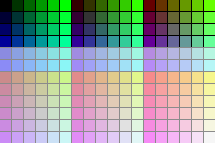First, thank you for considering my ideas, about your question, exactly, I was referring to loading a static image as the main color source, since when working with a considerable volume of colors, it can become confusing to manage.
For example, here you can see a comparison of how YY-CHR presents the colors, following a logical order, compared to the imported version, by its application, which although functional, is not as intuitive as the original.

Something that becomes more evident, when you need to change the color source constantly.



